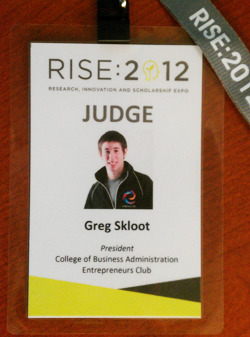
I know what you did last summer. Well, ok: that’s not true. But I do know what I did last summer: I tried my hand at a software startup, fell on my face, and learned a ton. Here’s the story:
It is January 2011. I am in Durham, NC, on co-op at Digitalsmiths, pretending to attend Duke University. In the cocktail hour before an entrepreneurial speaker at a campus event, I meet Kirill Klimuk, a freshman computer science major. Standing over a big bowl of chips and guacamole, acting as a scout for .406 Ventures looking for hotshot hackers I ask Kirill what he’s up to. He proceeds to explain what sounds like one of the craziest ideas I have ever heard: concocting some sort of web of information, making it easier for people or organize and share data online, and a whole bunch of other jargon. I have no idea what the heck he’s talking about. However, something tells me he’s special. So after the event I track him down and send an email inviting him to dinner.
We meet at 6pm on a Sunday evening at Panda Express on Duke’s campus. We end up sitting in that restaurant for 6 hours straight.We talk about everything from our childhoods, to our obsession with Legos, and the intricacies of this very clever idea Kirill had. The basic premise of the idea is that there is a lot of information content online (news articles, blog posts, etc) and we’d filter out the uninteresting stuff and only show people the content that they actually care about. At around midnight we leave, shaking hands as business partners in this new venture.
Now, we weren’t signing contracts or NDAs: we were just two students working on a project. So we meet every Friday, Saturday, and Sunday night while everyone else was out partying. We would sit in front of whiteboards from 5pm to midnight putting together the components of our product to make it work like a well-oiled machine. Working was glorious intoxication: we loved it and couldn’t get enough of it. We had a mission: to be a destination website where people could go to discover every topic from technology to mountain biking. One night we stayed up until 3am, filling the room with diagrams, outlines and mockups of our baby, which we called Quiree, after inquiry (a search leading to discovery). It couldn’t have been any more fun.
We did this all semester and all through spring break. At the end of the semester Kirill’s classes ended and so did my job, so we decided to walk away from high paying tech internships and work on this crazy idea full time, all summer. We decided we were really serious about the company and incorporated it to protect the IP, working with a great startup lawyer in Chapel Hill, NC. My parents, as crazy as they are, agreed to let us both live in their house in NY. So sure enough, I came back from co-op with a Duke student to live in my parents’ house in mid-May.
We settled in and made a rigorous schedule. We started work around 9:45am and ended work around 11:00pm every day, with a couple of breaks for lunch, dinner and sanity. We did this 7 days a week.It was madness. As the weeks turned it to months, it became more and more challenging to keep up our insane work ethic. No going to the beach, no enjoying summer, or being kids. We were crafting code, graphics, and layouts like gears churning in a engine, without an off switch.
It was finally the beginning of August, and we had finished our website. It was amazing: we built it! Everything functioned just as we had drawn it out on the white boards months ago. It was still a minimum viable product (in our eyes at least), but, man was there a lot to it. Bells, whistles, the works. Features stacked up like a skyscraper and the instruction manual thickened with guidelines of how to use the product. We started sending the link out to our friends and colleagues to try out. They gladly signed up, looked around for about 60 seconds, left and never came back.
“Oh, crap” we said. Realizing that there were a ton of flaws that we could quickly identify and repair, we set out to iterate and create the next version to release again in a week. We cranked it out during the week and sure enough pushed a new version out. It was a big improvement, butusers still did not seem to understand it or want to use it. Maybe it wasn’t social enough? So we added more Facebook and Twitter integration, more opportunities for users to interact and discuss topics they were interested in and comment on news content. But again, people tried it and left, not really giving it a chance or understanding what it could do for them.
At this point it was mid-August. School was going to start soon, and the project looked like it needed to a major pivot that would require massive re-coding. Kirill and I were so tired that we could barely lift a finger. Our spirits were down, our energy depleted, our enthusiasm at an all time low. Suddenly, going to class didn’t seem so bad at all. At that point we made a choice to put our product on the shelf, and so ended the story of Quiree.
What did we learn?
1. Simplicity
Products MUST be simple. The best software product is a button that does one thing the same way every time. Our product had 50 buttons that were color coded and felt like an airplane cockpit command center to most of our users. On top of that, the interface was so busy that users didn’t understand what they were looking at. You need to be able to sum up in one sentence what your product is, and it needs to be in clear, simple language. Ex: “My product is a software program where you can voice and video chat with your friends.” – Skype. Or, “My product is a website that teaches you how to code.” – Codecademy. Simple, simple, simple.
Here’s a guideline to simplify your product. Dream it up, write down all of the features you believe are necessary. Now, ditch half of them. I mean it, ditch them right now. And now, cut the amount of features left in half. There: that is your minimum viable product. Seriously. It needs to be MINIMUM, the absolute bare essentials.
2. The user is LAZY
One of our biggest mistake was overestimating our average user. My partner and I are technical guys. We build software and understand its intricacies. But the average user doesn’t always realize the most basic aspects of navigation on the web, like the issues of using the browser’s back button from within a web application. Your product must be so EASY to use and so OBVIOUS that the user does not have to exert energy trying to figure it out, because I assure you that they will not. Instead, they will simply walk away from the product.
3. Design and User Experience (UX) are key
Neither my partner nor I were great designers. It showed: our product was ugly. There are some really beautiful products out there that place a great emphasis on design, like Zaarly. Do yourself a favor: have a design co-founder on your team or hire a top notch firm like Bionic Hippo to consult on UI/UX. If your product is not appealing to the eye and warming to the soul, people won’t want it.
4. Pivot quickly
If a software product takes 4 months to code, you are probably doing something wrong. Get something out quickly (i.e. in weeks), get user feedback, and test again. We spent way too much time on our first iteration. Adapt to what your customers want and be willing to completely change your product or business model to suit the needs of your customers. There is zero room for stubbornness in web software startups, especially targeting mass consumer markets.
5. Partners will fight
You start out your business loving your partner. You are best friends; all is sweet in the world, etc. I promise that at some point in your career, you will fantasize about smashing your partner’s head into a telephone pole. It is ok; it is normal. Remember, you are all people. You have your own opinions, desires, and agendas. You need to learn when to give each other space, when to compromise, when to take a stand, and when to back down. Most importantly, you need to act like a decent human being, otherwise nobody will care how smart or skilled you are, and they won’t work with you.
6. Cost control is good
My partner and I lived for free in my parent’s house (and ate their food). Luckily we were young enough to be able to play that card. At the end of this adventure, we lost very little money. We spent a lot of time, but we also learned a lot. Our costs were incredibly low. Position yourself the same way.
7. Code, code, code
We learned a ton about coding through this experience, and anyone who tries to attack a similar venture will too. I became comfortable with JavaScript and my partner had PHP shooting out of his fingers.
8. Product management
It is really easy to get picky on details of the product. Don’t do that – it is not important in the beginning. Whether the icon is blue or orange doesn’t freakin’ matter. What is important:do people understand your product? Is it easy to use? Does the basic functionality work properly? Can you easily scale it when the time comes?
So, that is the story. It was a magnificent summer and I learned a huge amount. I’m very glad I took the plunge to make our crazy idea a reality and despite it being a commercial failure, it was certainly an experiential success.
Thanks to Kirill Klimuk for his input on this post.
 I walk into the office on a warm Friday afternoon to find Freshmen Entrepreneurs Club member Nina Stapanov peering over a pile of boxes with tape in one hand and markers in another. “The closet is a mess so I’m cleaning it up!” declares Nina with a smile. She is right – the club’s closet in our Curry Student Center office is a disaster with old napkins and pens littering the shelves. Over 2 hours later, Nina is beaming in front of the closet and I cannot believe my eyes: all of our materials are in labeled boxes, the shirts are organized by size and a year’s worth of junk is discarded. “This is incredible Nina, thank you!” I say. What blows my mind is not how great the closet looks, but how Nina took initiative to do a mundane task without even being asked. Nobody assigned it to her and it isn’t in her job description; in fact, she doesn’t even start her role as Assistant Director of Marketing until next fall. Instead, Nina took it upon herself to clean out the closet because she is a team player who truly cares. She will do whatever she believes will better our organization, and the closet cleanup is just the most recent example. This exemplifies why Nina is such a great member of our team. I don’t need to delegate things to her; instead, she will take it upon herself to look for problems and fix them.
I walk into the office on a warm Friday afternoon to find Freshmen Entrepreneurs Club member Nina Stapanov peering over a pile of boxes with tape in one hand and markers in another. “The closet is a mess so I’m cleaning it up!” declares Nina with a smile. She is right – the club’s closet in our Curry Student Center office is a disaster with old napkins and pens littering the shelves. Over 2 hours later, Nina is beaming in front of the closet and I cannot believe my eyes: all of our materials are in labeled boxes, the shirts are organized by size and a year’s worth of junk is discarded. “This is incredible Nina, thank you!” I say. What blows my mind is not how great the closet looks, but how Nina took initiative to do a mundane task without even being asked. Nobody assigned it to her and it isn’t in her job description; in fact, she doesn’t even start her role as Assistant Director of Marketing until next fall. Instead, Nina took it upon herself to clean out the closet because she is a team player who truly cares. She will do whatever she believes will better our organization, and the closet cleanup is just the most recent example. This exemplifies why Nina is such a great member of our team. I don’t need to delegate things to her; instead, she will take it upon herself to look for problems and fix them.  I’m thrilled to announce that rising junior
I’m thrilled to announce that rising junior  I recently had the honor of being a judge at Northeastern’s
I recently had the honor of being a judge at Northeastern’s  Sophomore Program Director
Sophomore Program Director  Praise is an amazing thing. It can create powerful feelings and motivate people to perform, and yet it costs nothing and takes minimal effort. Praise is one of the best tools a manager has to keep the team happy and productive. Take the following email example from me to a Director on my team:
Praise is an amazing thing. It can create powerful feelings and motivate people to perform, and yet it costs nothing and takes minimal effort. Praise is one of the best tools a manager has to keep the team happy and productive. Take the following email example from me to a Director on my team: It is 4pm on a Thursday when Freshmen
It is 4pm on a Thursday when Freshmen  Managing a team of people is challenging, fun and rewarding. You need to give them guidance, set goals and deliverables, provide feedback and foster a top notch culture. If someone on the team isn’t living up to the expectations of their role, they risk losing their job and income. Losing the income from a job is key… many people fear it and this sometimes helps motivate them to perform. But what happens when we take money out of the equation… what about managing volunteers?
Managing a team of people is challenging, fun and rewarding. You need to give them guidance, set goals and deliverables, provide feedback and foster a top notch culture. If someone on the team isn’t living up to the expectations of their role, they risk losing their job and income. Losing the income from a job is key… many people fear it and this sometimes helps motivate them to perform. But what happens when we take money out of the equation… what about managing volunteers?
 Last year, I served as the Director of our largest program at the Entrepreneurs Club, the
Last year, I served as the Director of our largest program at the Entrepreneurs Club, the 